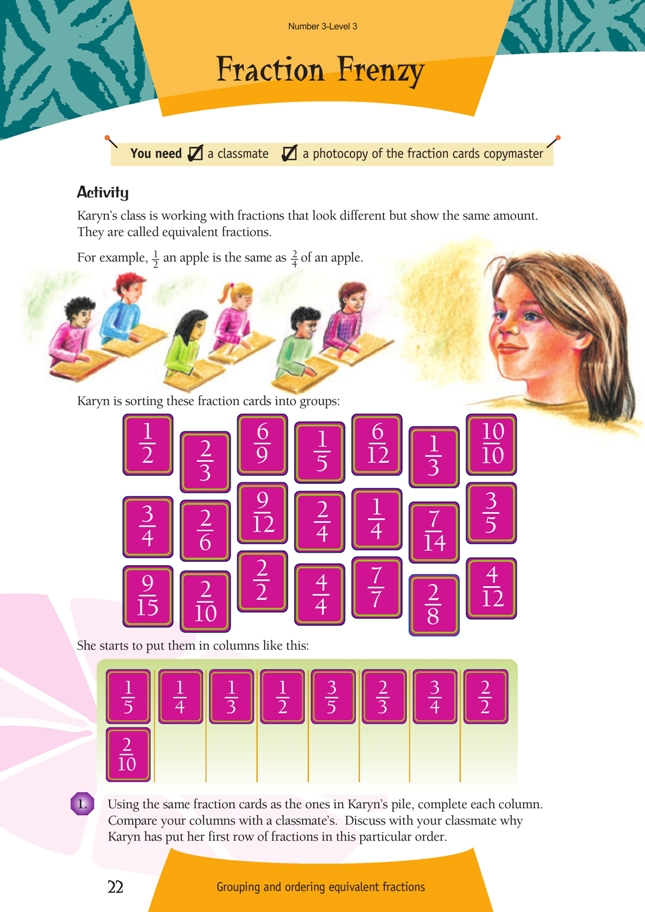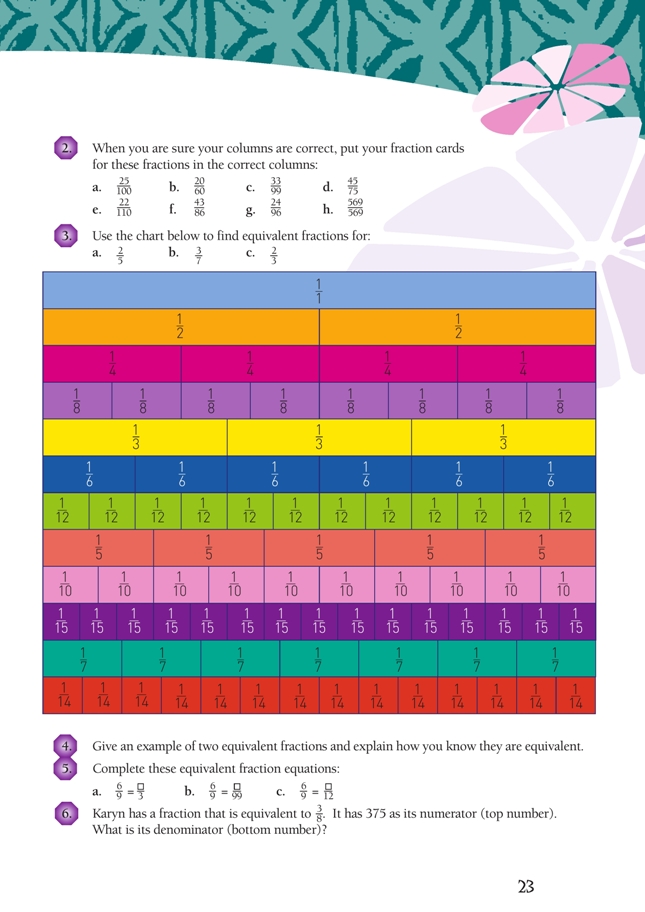This is a level 3 number activity from the Figure It Out series.
A PDF of the student activity is included.
Click on the image to enlarge it. Click again to close. Download PDF (205 KB)
order fractions
find equivalent fractions
FIO, Level 3, Number, Book 3, Fraction Frenzy, pages 22-23
A classmate
Before the students start this activity, you might like to work through two earlier Figure It Out activities with them. Fabulous Folding, Number, Figure It Out, Levels 2–3, page 18, uses a simple number line to place fractions in order. (You can extend this later in relation to Fraction Frenzy.) Fun with Fractions, Number, Figure It Out, Level 3, page 9, uses paper circles to explore simple equivalent fractions.
In Fraction Frenzy, the students explore the simple equivalence of fractions. They also discuss the order of fractions. The activity can be extended to investigating whether there is a rule for changing a fraction into an equivalent fraction.
In question 1, the students sort a set of fraction cards (see the copymaster at the end of these notes) into equivalent sets. In the process, they order them from smallest to largest. If they are not aware of this sequencing, it should become apparent to them in their discussion with a classmate.
There are various ways of helping the students who have difficulty with this question. You could direct them to the fraction wall in question 4 and help them to explore it, or you could use a simpler fraction wall and link a number line to it:
Get the students, perhaps in pairs, to make the fractions on the wall out of strips of paper (they need to be the right lengths), for example, 1/5, 2/5, 3/5, and so on, and then align their strips to create a fraction number line:
A fraction wall such as the one below is a good way to teach the students about different ways of writing fractions:
Before they do question 2, the students need to check their columns from question 1. They could do this with a classmate. They then go on to place further equivalent fractions into the correct columns. If necessary, lead the students to realise that they can find equivalent fractions by looking for patterns in the numerators and denominators. For example, with 25/100, 25 goes into 100 four times, so it is equivalent to 1/4. With 45/75, we can see that both numbers are divisible by 5, so we get 9/15. In turn, both these numbers are divisible by 3, so we get 3/5.
Question 4 asks the students to explain how two fractions are equivalent. Have them explain this to another classmate first and then get them to write out their explanation. The writing can be used for teacher assessment or for self- or peer-assessment and will also help the students to internalise the concept.
In question 5, the students are given only the denominator of the second fraction and have to find its numerator to make it an equivalent fraction. After completing the previous questions, the students should see that a quick way of finding equivalent fractions is to multiply the numerator and denominator by the same number. If they do not understand this, have them make further equivalent fractions with materials and then say and write the names. Rather than giving them the “rule”, help the students to find it for themselves.
Question 6 requires a good knowledge of multiplication and division basic facts because the students have to multiply and divide by 3 and 8. They need to search for a link between the two numerators 3 and 375. Encourage them to see that 375 is 3 x 100 + 3 x 25, that is, 3 lots of 125. The students need to identify the relationship between the two numerators:
They then need to apply that relationship to the denominator to maintain the “equivalence” between the fractions.
Further discussion and investigation
Have the students make their own fractions and then place them on number lines. Include fractions greater than 1. Ask them to name fractions equivalent to those shown. Discuss why 1/1, 2/2, 5/5, and so on are all equal to 1.
Answers to Activity
1. Practical activity. Your columns should have equivalent fractions in them. (Equivalent fractions are different ways of expressing the same fraction.)
Karyn has arranged her first row from the smallest to the largest fraction.
2. a. in the 1/4 column
b. in the 1/3 column
c. in the 1/3 column
d. in the 3/5 column
e. in the 1/5 column
f. in the 1/2 column
g. in the 1/4 column
h. in the 2/2 column
3. a. 2/5 = 4/10 or 6/15
b. 3/7 = 6/14
c. 2/3 = 4/6, 8/12, or 10/15
4. Answers will vary. For example, 2/6 and 4/12 both simplify to 1/3. They all take up the same length on the fraction wall. The top number (the numerator)
and the bottom number (the denominator) can both be divided by 2 (and in the case of 4/12, by 2 again) to get 1/3. So, equivalent fractions simplify to the same simplest
form. Another example is 4/10 and 8/20, which both simplify to 2/5, so they are equivalent fractions.
5. a. 6/9 = 2/3
b. 6/9 = 66/99
c. 6/9 = 8/12
6. 1 000





